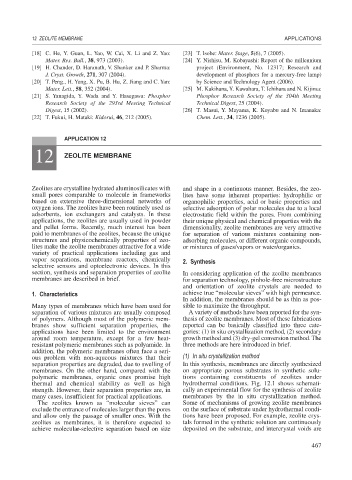Page 495 - Book Hosokawa Nanoparticle Technology Handbook
P. 495
12 ZEOLITE MEMBRANE APPLICATIONS
[18] C. He, Y. Guan, L. Yao, W. Cai, X. Li and Z. Yao: [23] T. Isobe: Mater. Stage, 5(6), 7 (2005).
Mater. Res. Bull., 38, 973 (2003). [24] Y. Nishisu, M. Kobayashi: Report of the millennium
[19] H. Chander, D. Haranath, V. Shanker and P. Sharma: project (Environment, No. 12317; Research and
J. Cryst. Growth, 271, 307 (2004). development of phosphors for a mercury-free lamp)
[20] T. Peng., H. Yang, X. Pu, B. Hu, Z. Jiang and C. Yan: by Science and Technology Agent (2006).
Mater. Lett., 58, 352 (2004). [25] M. Kakihana, Y. Kawahara, T. Ichihara and N. Kijima:
[21] S. Yanagida, Y. Wada and Y. Hasegawa: Phosphor Phosphor Research Society of the 304th Meeting
Research Society of the 293rd Meeting Technical Technical Digest, 25 (2004).
Digest, 15 (2002). [26] T. Masui, Y. Mayama, K. Koyabu and N. Imanaka:
[22] T. Fukui, H. Mataki: Kidorui, 46, 212 (2005). Chem. Lett., 34, 1236 (2005).
APPLICATION 12
12 ZEOLITE MEMBRANE
Zeolites are crystalline hydrated aluminosilicates with and shape in a continuous manner. Besides, the zeo-
small pores comparable to molecule in frameworks lites have some inherent properties: hydrophilic or
based on extensive three-dimensional networks of organophilic properties, acid or basic properties and
oxygen ions. The zeolites have been routinely used as selective adsorption of polar molecules due to a local
adsorbents, ion exchangers and catalysts. In these electrostatic field within the pores. From combining
applications, the zeolites are usually used in powder their unique physical and chemical properties with the
and pellet forms. Recently, much interest has been dimensionality, zeolite membranes are very attractive
paid to membranes of the zeolites, because the unique for separation of various mixtures containing non-
structures and physicochemically properties of zeo- adsorbing molecules, or different organic compounds,
lites make the zeolite membranes attractive for a wide or mixtures of gases/vapors or water/organics.
variety of practical applications including gas and
vapor separations, membrane reactors, chemically 2. Synthesis
selective sensors and optoelectronic devices. In this
section, synthesis and separation properties of zeolite In considering application of the zeolite membranes
membranes are described in brief. for separation technology, pinhole-free microstructure
and orientation of zeolite crystals are needed to
1. Characteristics achieve true “molecular sieves” with high permeance.
In addition, the membranes should be as thin as pos-
Many types of membranes which have been used for sible to maximize the throughput.
separation of various mixtures are usually composed A variety of methods have been reported for the syn-
of polymers. Although most of the polymeric mem- thesis of zeolite membranes. Most of these fabrications
branes show sufficient separation properties, the reported can be basically classified into three cate-
applications have been limited to the environment gories: (1) in situ crystallization method, (2) secondary
around room temperature, except for a few heat- growth method and (3) dry-gel conversion method. The
resistant polymeric membranes such as polyamide. In three methods are here introduced in brief.
addition, the polymeric membranes often face a seri-
ous problem with non-aqueous mixtures that their (1) In situ crystallization method
separation properties are degraded, due to swelling of In this synthesis, membranes are directly synthesized
membranes. On the other hand, compared with the on appropriate porous substrates in synthetic solu-
polymeric membranes, organic ones promise high tions containing constituents of zeolites under
thermal and chemical stability as well as high hydrothermal conditions. Fig. 12.1 shows schemati-
strength. However, their separation properties are, in cally an experimental flow for the synthesis of zeolite
many cases, insufficient for practical applications. membranes by the in situ crystallization method.
The zeolites known as “molecular sieves” can Some of mechanisms of growing zeolite membranes
exclude the entrance of molecules larger than the pores on the surface of substrate under hydrothermal condi-
and allow only the passage of smaller ones. With the tions have been proposed. For example, zeolite crys-
zeolites as membranes, it is therefore expected to tals formed in the synthetic solution are continuously
achieve molecular-selective separation based on size deposited on the substrate, and intercrystal voids are
467

